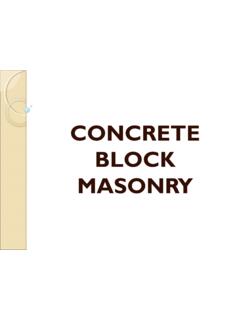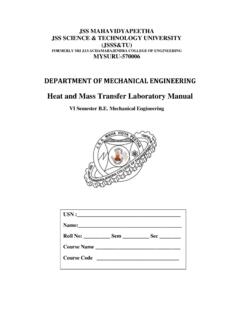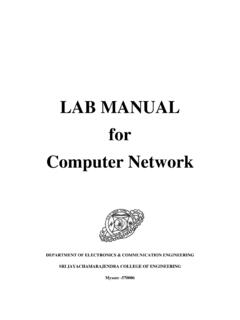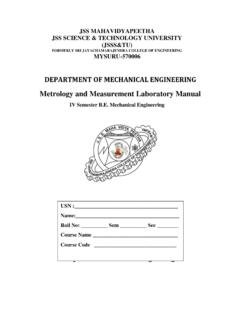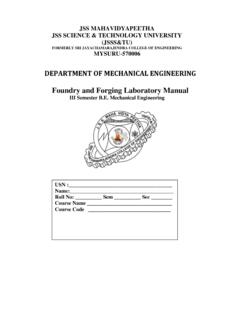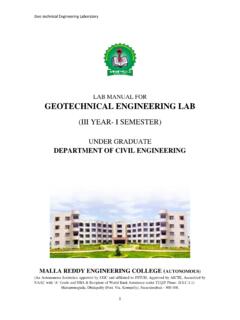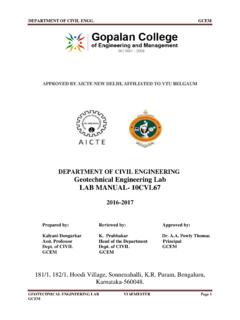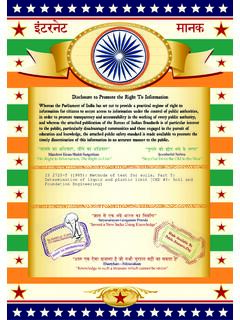Transcription of GEOTECHNICAL ENGINEERING LABORATORY
1 IGEOTECHNICAL ENGINEERINGLABORATORYINSTRUCTION MANUALforVI Semester Civil EngineeringandVSemester and EditedbyDr. K. PrakashProfessorDepartment of Civil EngineeringSri Jayachamarajendra College ofEngineering, Mysuru 570006.(Autonomous Institution)ii1stEdition 2015iiiFOREWORDTheGeotechnical EngineeringLaboratory intends to train the studentsinthe field of testing ofsoilstodetermine their physical, index and instruction manual guides the students to conduct the test as perBureau of Indian Standard procedures. The students shall follow the guidelinesindicated for conducting the testsformore effective,for better understandingandfor logically interpreting the results. Before conducting any test, students shall come prepared with theoreticalbackground of the corresponding test (indicated under the section theory in each test).
2 Students shall make sure to have the knowledgeof measuringinstruments like slide calipers, screw gauge and other gauges. Students shall give importance to accuracy and precision while conductingthe test and interpreting the results. Students shall acquaint themselves with the safe and correct usage ofinstruments / equipments under the guidance of teaching / supportingstaff of the is hoped that this instruction manual will serve to orient the students inthe right direction ofsoiltesting. The author thanksMr. Naveen Kumar forhis excellent efforts in typesetting and in bringing out this instruction manual inthe present PrakashivvCONTENTSPage No. Forewordiii ContentsvPhysical / Index Property Tests on of specific gravity ofA)coarse grainedB)fine-grained of Atterberg limits of fine-grained soilsA)Determination of liquid limit( casagrande method)B)Determination of plastic limitC)Determination of shrinkage of liquid limit of fine-grained soils by fallcone ofin situdry densityA)Core cutter methodB)Sand Replacement tests27 ENGINEERING Property Tests on of coefficient of permeability of soilsA)Constant head permeability testB)Variable head permeability of compaction characteristics of soilsA)Indian standard light compaction testB)Indian standard heavy compaction Vane Shear shear test(Direct Shear Test) compression , undrained triaxial compression dimensional consolidation test53 GEOTECHNICAL EngineeringLab Instruction GRAVITY[A] Aim.
3 To determine the specific gravity ofacoarse grained soilsamplebyPycnometer :Specific gravity-true specific gravity, apparent specific gravity; significanceand Pycnometer with a conical cap screwed at its top Balance, sensitive to g Wash bottle with deaired, distilled water Glass rod, about 150 mm and 3 mm diameter Thermometer with 0-50oC range and accurate to 1oC. Thermostatically controlled Clean the Pycnometer,and dry it. Find the mass of the Pycnometer with its cap andwasher, accurate to g (Ml). Introduce about 400 g of oven dried coarse grained soil in to the Pycnometer. Recordthe mass of the Pycnometer with its cap and washer along with the soil (M2). Fill the Pycnometer with distilled water to half its height, and mix it thoroughly withthe soil using the glass rod. Keep the entire system aside for about 4 hrs. At the endof this period, fill the Pycnometer with water up to the top of the conical cap.
4 Dry thePycnometer from outside and record its mass (M3). Clean the Pycnometer thoroughly. Fill it with distilled water up to the top of conicalcap. Dry the Pycnometer from outside and record its mass to the nearest g (M4). Repeat the steps (2) and (3) thrice. Calculate the specific gravity of the soil at the room temperature as well as at and EngineeringLab Instruction Manual2 Observations and CalculationsSoil type:Lab. Temp. = T0C =Determination of Pycnometer (M1) of (Pycnometer +soil)(M2) of (Pycnometer +soil +water)(M3) of (Pycnometer +water)(M4) specific gravity at lab temperature (GT) specific gravity at 270C (G27)Note: Calculate the average ofthe three determinations and report it to the nearest the results differ by more than from the average value, repeat the calculationsi) GT=)M-(M-)M-(M)M-(M431212=ii) Average specific gravity at 270C = G27= 27waterTwaterTGGGR elevant BIS Code:IS: 2720 (Part 3 / Sec.
5 1) 1980 (Reaffirmed 1987). EngineeringLab Instruction Manual3[B]Aim:To determine the specific gravity ofafine-grained soilsampleby density Density bottle of approximately 50 ml capacity with stopper. A vacuum pump A vacuum desiccator A balance, sensitive to g Wash bottle with deaired, distilled water Rubber tubing to connect the vacuum pump and the desiccator A thermometer with 0-50oC range and accurateto 1oC. A desiccator containing anhydrous silica gel. Thermostatically controlled Clean and dry the density bottle with stopper at 105oC to 110oC. Cool it in adesiccator and determine its mass to the nearest g (M1). Take about 10g of oven dried fine-grained soil and transfer it to the density bottledirectly from the desiccator in which it has been cooled. Record the mass of thedensity bottle with stopper and the soil to the nearest g (M2).
6 Add de-aired, distilled water tothe density bottle such that the soil is just coveredwith water. Place the bottle containing the soil and water without stopper in a vacuumdesiccator and evacuate gradually. Allow the bottle to remain in the desiccator for atleast1 hour until no further loss of air is apparent. Release the vacuum. Take the bottle out of desiccator and fill it up to the calibratedmark with de-aired, distilled water. Wipe dry the outside of the bottle. Record the mass of the stoppered bottle containingthe soil and water to the nearest g (M3). Clean the bottle thoroughly. Fill it with de-aired, distilled water up to the calibratedmark. Wipe dry the outside of the bottle. Record the mass of the stoppered bottle withwater to the nearest g (M4). Repeatthe steps (2) to (5) twice. Calculate the specific gravity of the soilsampleat the room temperatureand at : If any liquid other than de-aired, distilled water is used to conduct the test, thencalculate the specific gravity of the soilwithrespect to distilled waterusing the )M-(M-)M-(M)M-(M431212GL-----(3)where GL= Specific gravity of the liquid used at lab EngineeringLab Instruction Manual4 Results and discussions:---------------------------- ---------------------------------------- ---------------------------------------- Observations and CalculationsSoil typeLab.
7 Temp. = T0C =Liquid used in the test:Determination bottle of Density bottle(M1)gMass of (Density bottle +soil)(M2)gMass of (Density bottle +soil +liquid)(M3)gMass of (Density bottle +liquid)(M4)gSpecificgravity with respect to test liquid (Gl)Average specific gravity with respect to test liquidat lab temperature (Gl)avAverage specific gravity with respect to water atlab temperature (Gav)TAverage specific gravity at 270C (G27)Note:Calculate the average of the two determinations and report it to the nearest Ifthe two results differ by more than , repeat the calculationsi)GTL=)M-(M-)M-(M)M-(M431212 =ii) Specific gravity with respect to water atroom temperature=GT= GTLxSpecific gravity of test liquid =iii) Average specific gravity at 270C = G27= 27waterTwaterTGGG=RelevantBIS Code:IS: 2720 (Part 3 / Sec. 1) 1980 (Reaffirmed 1987) GEOTECHNICAL EngineeringLab Instruction ANALYSISAim:To determine the grain size distribution of the given soil :Particle size classification of soils: IS system, MIT system, Differentiation: claysize fraction and clays; particle size distribution curves, characteristic sizes, well gradedand poorly graded soils; gradation of IS sieves: , 2mm, 1mm, 600 micron, 425 micron, 300 micron, 212micron, 150 micron, 106 micron, 75 to clean the sieve controlledhot dry the given soil sample passing mm IS 200 g of oven dried soil sample.
8 Mix the sample with distilled water to form aslurry and allow it for the soaked soil sample through 75 micron sieve until the waterpassing throughthe sieve is substantially the fraction of the soil retained on 75 micron sieve in the remaining sieves one above the other such that 2mm sieve is at the topand 75 micron sieve is at the bottom. Place a cover at the top and receiver at the set of sieves to the mechanical sieve shaker. Operate the sieve shaker for aminimum of 10 collect and record the mass of the soil fraction retained on each sieve andalsoin the the cumulative mass of soil fraction retained on each sieve. Calculate thepercentage a graph of percentage finer (along y-axis) Vs equivalent particle diameter in mm(along x-axis in log scale). Draw a smooth curve encompassing theplotted the values of percentage sand, percentage silt and percentage clay sizefractionsfrom the D10, D30and D60from the coefficient of curvature (CC) and coefficient of uniformity (CU).
9 The soil based on and Discussions:. EngineeringLab Instruction Manual6 Observation and CalculationsTotal mass of soil taken for analysis = M = SievePracticalsizeD, mmMassretainedm , gCorrected massretainedm, g%retainedCumulative% retained% finer (N) mm1mm1mm600 =Specimen CalculationsCorrected mass retained = m = m xMM =From the graph1)The given soil is _____ )(i) % sand =(ii) % silt =(iii) % clay size =3)(i) D10=(ii) D30=(iii) D60=4)(i) Coefficient of uniformity = CU= D60/ D10= _____(ii) Coefficient of curvature = CC=DxD)(D6010230= _____5)Particle size and gradation classification of the given soil: _____(reason: _____)RelevantBIS Code:IS 2720-Part 4, 1985 GEOTECHNICAL EngineeringLab Instruction ANALYSISAim:To determine percentage silt size and clay size fractions of thegiven soil byhydrometer :Sedimentation analysis: Principle and assumptions made.
10 Hydrometer analysis;Calibration of hydrometer, corrections to hydrometer 1000 ml capacity measuring agents-Sodium hexa meta phosphate and sodium controlled hot air the hydrometer to be used in the the meniscus about 50 g of oven dried soil sample passing 75 IS the soil to pre-treatment to remove soluble salts or organic matter orcalcium compounds, if g of sodium hexa meta phosphate and g of sodium carbonate in100 ml distilled water. Transfer the solution to 1000 ml capacity jar and adddistilled water to make the volume of the solution to 1000 ml (This dispersionagent solution is required for getting the composite correction). the measured quantity of soil in a beaker. Add 100 ml of solution preparedby dissolving g of sodium hexa meta phosphate and g of sodium carbonatein distilled water to the the soil suspension gently for about 10 the soil suspension to the cup of a mechanical stirrer using about 100 mlof distilled water.
